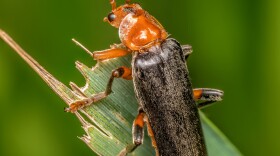While summer may not be the time most people think of heading to the Arizona desert, for bug lovers it’s the best time of year.
Thanks to a seasonal shift of winds that brings moisture northward from the Gulf of Mexico, it’s monsoon season, bringing heavy rain to this otherwise parched part of the world.
With these rains comes an amazing transformation. Plants and many animals that have been waiting for the monsoon rains to arrive now have their time to shine. The incredible diversity of life in the desert is suddenly on full display.
The Giant Velvet Mite is just one amazing example.
In this case, “Giant” is definitely a relative term. While most species of mites range from .01 to .03 inches in length, Giant Velvet Mites stretch the tape measure to a whopping quarter of an inch or more.
Covered in fine hairs, these mighty mites are a striking red color. Some species have patches of white on their body, reminding me of the contrasting colors of a piece of peppermint candy …without the swirls and with eight wriggling legs instead of a wrapper.
The adults feed on termites, while the larvae are parasitic, feeding on tiny arthropods and their eggs.
Giant Velvet Mites are arachnids and spend most of their lives underground in the soil or sand, becoming active on the surface after heavy rain …the reason that the monsoon season is a great time of year to find them.
If you’re lucky enough to spend some time in Arizona’s desert during the monsoon season, be prepared to witness an amazing time of transformation as plants and animals welcome the rains in their own unique ways.





